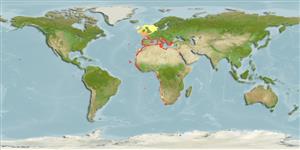Common names from other countries
Environment: milieu / climate zone / depth range / distribution range
Ecología
marino; salobre demersal; no migratorio; rango de profundidad 20 - 500 m (Ref. 4510), usually ? - 150 m (Ref. 27000). Subtropical; 60°N - 35°S, 26°W - 36°E
Eastern Atlantic: British Isles (rare) to Senegal including Madeira, the Canary Islands, and Cape Verde. Also throughout the Mediterranean except Black Sea. South African species thought to be the same as population in the northeast Atlantic (Ref. 4313).
Tamaño / Peso / Age
Maturity: Lm ? range ? - ? cm
Max length : 50.0 cm TL macho / no sexado; (Ref. 4510); common length : 30.0 cm TL macho / no sexado; (Ref. 2683); peso máximo publicado: 3.0 kg (Ref. 40637)
Short description
Claves de identificación | Morfología | Morfometría
Espinas dorsales (total) : 12; Radios blandos dorsales (total) : 9; Espinas anales: 3; Radios blandos anales: 5. Dark spot often on spinous dorsal (Ref. 4313).
Solitary and sedentary over rocky, sandy or muddy bottoms. Feeds on fishes, crustaceans and mollusks (Ref.4570).
Life cycle and mating behavior
Maturities | Reproducción | Spawnings | Egg(s) | Fecundities | Larva
Hureau, J.-C. and N.I. Litvinenko, 1986. Scorpaenidae. p. 1211-1229. In P.J.P. Whitehead, M.-L. Bauchot, J.-C. Hureau, J. Nielsen and E. Tortonese (eds.) Fishes of the North-eastern Atlantic and the Mediterranean. UNESCO, Paris. Vol 3. (Ref. 4570)
IUCN Red List Status (Ref. 130435)
CITES (Ref. 128078)
Not Evaluated
Human uses
Pesquerías: comercial; Acuario: Acuarios públicos
Herramientas
Special reports
Download XML
Fuentes de Internet
Estimates based on models
Preferred temperature (Ref.
115969): 11.1 - 18, mean 14.4 (based on 189 cells).
Phylogenetic diversity index (Ref.
82804): PD
50 = 0.5000 [Uniqueness, from 0.5 = low to 2.0 = high].
Bayesian length-weight: a=0.01318 (0.01129 - 0.01539), b=3.02 (2.98 - 3.06), in cm Total Length, based on LWR estimates for this species (Ref.
93245).
Nivel trófico (Ref.
69278): 4.3 ±0.5 se; based on diet studies.
Resiliencia (Ref.
120179): Bajo, población duplicada en un tiempo mínimo de 4.5-14 años (K=0.08).
Fishing Vulnerability (Ref.
59153): High to very high vulnerability (68 of 100).
Climate Vulnerability (Ref.
125649): Low vulnerability (18 of 100).
